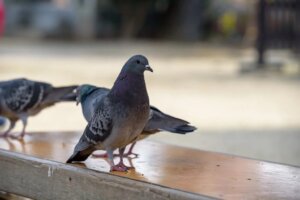Ornithophobia or Fear of Birds

Phobias are the most common form of anxiety disorder in the population. One such phobia is ornithophobia or fear of birds. Specific phobias and more, specifically animal phobias, often appear in childhood. Furthermore, they hardly ever disappear without treatment.
Ornithophobia
Ornithophobia is a specific phobia. These are anxiety disorders characterized by an irrational, intense, and disproportionate fear of a certain stimulus. In this case, birds.
Sufferers of specific phobias also exhibit avoidance behaviors, psychological symptoms (fear of even thinking about birds), and physiological symptoms. These might be tachycardia, sweating, or pressure in the chest when thinking about the stimulus or faced with it.

Irrational fear and avoidance behaviors
Phobias go beyond fear. In fact, they involve panic or extreme anxiety. Generally, phobias involve stimuli that aren’t necessarily dangerous. However, even if they could prove threatening, the phobia symptoms are still disproportionate.
With specific phobias, as in the case of ornithophobia, sufferers will avoid the phobic stimulus at all costs.
The causes of ornithophobia
Specific phobias occur due to multiple causes. However, the most common is a traumatic experience with the phobic stimulus. In the case of ornithophobia, it’s likely that the sufferer will have had a bad experience with a bird. To a certain degree, the stimulus also produces disgust. This increases the emotional activation associated with the phobia.
Other common origins of ornithophobia involve seeing or hearing accounts of people having been attacked by birds. On the other hand, the sufferer may have a biological predisposition to anxiety disorders, which could explain the ornithophobia.
Treatment of ornithophobia
According to Marino Pérez’s Guide to Effective Psychological Treatments, there are two effective and validated treatments for specific phobias. These are exposure therapy and cognitive therapy.
Exposure therapy
With ornithophobia, exposure therapy involves gradually exposing the sufferer to birds. This is done, firstly, by imagining them. Next, they move on to real-life experiences, gradually getting closer to the birds, etc.
Normally, the patient establishes a hierarchy of threatening items, ranging from the least to the most threatening. Then, they gradually move through the list. The goal is for the sufferer to eventually be able to cope with the phobic stimulus without experiencing the physiological symptoms of the phobia (sweating, chest pressure, nausea, dizziness, etc.).
Cognitive therapy
Cognitive therapy works mainly through cognitive restructuring. The goal is to modify the dysfunctional thoughts of the sufferer regarding birds and to change them to more realistic and adaptive feelings.
Some of the thoughts a person with ornithophobia might have are “birds are dangerous”, “they might hurt me”, “they scare me”, and “I can’t control myself if I see one”.

Other approaches
These two approaches we mentioned above are the most recognized in the field of cognitive-behavioral therapy. However, there are other methods from other spheres which may be used. For example, brief strategic psychotherapy, which works on the basis of curiosity.
With this method, the patient is encouraged to develop curiosity rather than fear about the stimulus. It focuses on practical and creative solutions, also evaluating the strategies the patient has already tried.
The role of disgust in phobias
It’s important to differentiate between real panic and simple disgust. Because simple disgust, where there’s no fear, doesn’t equate to a phobia.
However, certain animal phobias are accompanied by a feeling of disgust towards the feared stimulus. For example, cockroaches. As a matter of fact, disgust does form the basis of many phobias. It’s that physical feeling of displeasure you experience when you see or smell something that you don’t like.
All cited sources were thoroughly reviewed by our team to ensure their quality, reliability, currency, and validity. The bibliography of this article was considered reliable and of academic or scientific accuracy.
- American Psychiatric Association –APA- (2014). DSM-5. Manual diagnóstico y estadístico de los trastornos mentales. Madrid: Panamericana.
- López, A. (2005). Fobias específicas. Facultat de Psicologia. Departament de Personalitat, Avaluació i Tractament Psicològics.
- Pérez, M., Fernández, J.R., Fernández, C. y Amigo, I. (2010). Guía de tratamientos psicológicos eficaces I y II. Madrid: Pirámide.
This text is provided for informational purposes only and does not replace consultation with a professional. If in doubt, consult your specialist.








